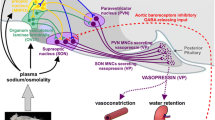Abstract
ANGIOTENSIN II induces short-latency water intake when infused intravascularly or injected into certain brain regions of mammals1,2. But conceptual difficulties arise if one asks why this should be so, and whether the data reflect real physiological actions. For example, angiotensin is a pressor hormone formed from kidney-based renin in response to challenge such as hypotension and hypovolaemia3–7. Water ingestion, in itself, is not an adaptive response to such challenges, since most ingested water is distributed intracellularly and will not relieve a vascular crisis. An adaptive response to hypotension or hypovolaemia would involve ingestion of an isotonic mix of fluids, since this would most rapidly and effectively increase vascular volume. In fact, hypovolaemia does result in an immediate increase in preference for isotonic saline over water and a delayed (6–10 h) acceptance of unpalatable hypertonic salt solutions8,9. But, a possible involvement of angiotensin as a rapid and direct facilitator of sodium intake (apart from a slow and indirect role through stimulation of aldosterone release) has not yet been reported and some evidence suggests that angiotensin may not play any significant role in regulating sodium intake in the rat10–12.
Similar content being viewed by others
References
Epstein, A. N., Fitzsimons, J. T., and Simons, B. J., J. Physiol. Lond., 210, 457 (1970).
Fitzsimons, J. T., and Simons, B. J., J. Physiol. Lond., 203, 45 (1969).
Peart, W. S., Pharmac. Rev., 17, 143 (1965).
Vander, A. J., Physiol. Rev., 47, 359 (1967).
Pitcock, J. A., Hartroft, P. M., and Newmark, L. N., Proc. Soc. exp. Biol. Med., 100, 686 (1959).
Brown, J. J., Davies, D. L., Lever, A. F., Robertson, J. I. S., and Verniony, A., J. Physiol. Lond., 182, 649 (1966).
Meyer, D. K., Peskar, B., Tauchmann, U., and Hartting, G., Eur. J. Pharm., 16, 278 (1971).
Stricker, E. M., and Jalowiec, J. E., Am. J. Physiol., 218, 191 (1970).
Stricker, E. M., and Wolf, G., J. comp. physiol. Psych., 62, 275 (1966).
Fitzsimons, J. T., and Stricker, E. M., Nature new Biol., 231, 58 (1971).
Radio, G. J., Summy-Long, J., Daniels-Severs, A., and Severs, W. B., Am. J. Physiol., 223, 1221 (1972).
Stricker, E. M., Physiol. Behav., 6, 299 (1971).
Fisher, A. E., and Coury, J. N., Science, 138, 691 (1962).
Fisher, A. E., in The Neurophysiology of Thirst (edit. by Epstein, A., Kissileff, H. R., and Stellar, E.) (Winston, in the press).
Block, M. L., and Fisher, A. E., Physiol. Behav., 5, 515 (1970).
Chiarviglio, E., and Taleisnik, S., Am. J. Physiol., 216, 1418 (1969).
Wolf, G., and Stricker, E. M., J. comp. Physiol. Psych., 63, 252 (1967).
Author information
Authors and Affiliations
Rights and permissions
About this article
Cite this article
BUGGY, J., FISHER, A. Evidence for a dual central role for angiotensin in water and sodium intake. Nature 250, 733–735 (1974). https://doi.org/10.1038/250733a0
Received:
Revised:
Issue Date:
DOI: https://doi.org/10.1038/250733a0
- Springer Nature Limited
This article is cited by
-
Neural circuits underlying thirst and fluid homeostasis
Nature Reviews Neuroscience (2017)
-
Distinct neural mechanisms for the control of thirst and salt appetite in the subfornical organ
Nature Neuroscience (2017)
-
Pass the salt: the central control of sodium intake
Nature Neuroscience (2017)
-
Taste Sensing Systems Influencing Metabolic Consequences
Current Oral Health Reports (2017)
-
Dipsogenic potentiation by sodium chloride but not by sucrose or polyethylene glycol in tuberomammillary-mediated polydipsia
Experimental Brain Research (2007)





